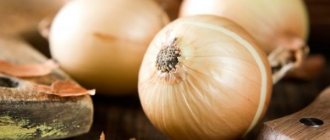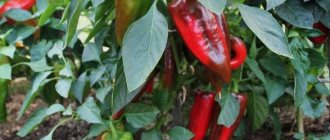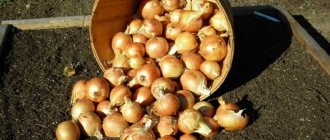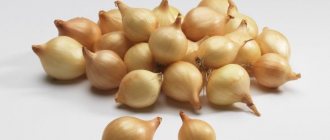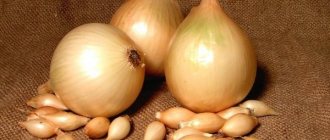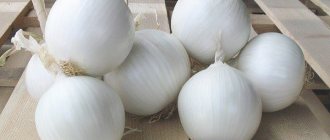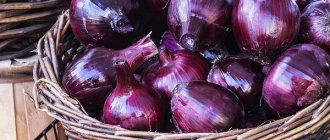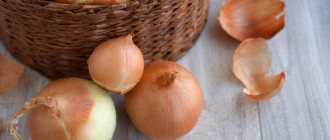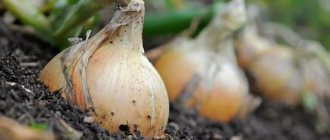Characteristics of winter onions Shakespeare
There are several main characteristics that characterize the Shakespeare winter onion and give it positive reviews. First of all, this is an early-ripening variety that produces one of the first crops among all known varieties of winter onions. The bulbs have excellent taste.
Productivity
With proper care and competent agricultural technology, you can harvest the crop within 70 days after the first shoots. Onion yield is 3.5 kg/m2. The fruits have a dense shell that helps withstand severe frosts. This allows you to grow the onions in question even in the conditions of the Siberian winter. Tolerates frosts down to – 18 °C.
Resistance to diseases and pests
Shakespeare onions before winter are perfect for beginning gardeners, as they are resistant to most diseases and pests. But the onion fly still affects the plant, and therefore preventive measures should be taken.
Important! When growing onions, you cannot use pesticides.
Advantages and disadvantages of the variety
The Shakespeare variety of winter onion has a number of advantages for which gardeners value this variety.
Advantages of the variety:
- the sets do not need to be stored until spring;
- ripens much earlier than what is sown in the spring;
- excellent taste;
- resistance to the formation of arrows;
- resistance to common onion diseases.
The only drawback of Shakespeare onions can be considered the shelf life, but this applies to all winter varieties.
Description
Shakespeare onions are early ripening varieties, as they require only 75 days to fully ripen. The presence of dense scales gives it the opportunity to overwinter when frosts reach -18ºС, and under snow cover it can tolerate even lower temperatures. The bulb of this winter plant is round, the scales are golden-brown in color, and the flesh itself is white and juicy, with a delicate semi-sharp taste. The average weight of one bulb is from 100 to 300 grams, which ensures good yield.
Dutch Shakespeare onions are one of the most popular winter varieties
The big advantage of this winter onion is that even with long-term storage it does not shoot arrows. In addition, it is resistant to diseases that affect root crops during the ripening phase.
Planting and caring for winter onions Shakespeare
In order to reap the maximum harvest, it is necessary to follow the rules of agricultural technology. Shakespeare onion sets are winter because it is not recommended to plant them in the spring. It is important to meet deadlines and properly prepare the land. The timing primarily depends on the climatic conditions of the region where planting takes place.
When to plant winter onions Shakespeare
The planting date may vary each year depending on air and soil temperatures. Usually this is the end of October and the beginning of November. If onions are planted too early, this will lead to early shoots and subsequent freezing. If planted late, the onions will not have time to take root before winter. The air temperature should be +5 °C. In this case, approximately 2 weeks should remain until the temperature reaches 0 °C. Winter onion sets of the Shakespeare variety take root and grow even in Siberia, but according to reviews, it is important to plant it a couple of weeks before the frost so that it does not freeze and has time to take root.
When to plant winter onions Shakespeare in Siberia
For planting in Siberia, earlier dates are required. At least a month must pass after planting before the onset of severe frosts. Therefore, in Siberia, the planting date is approximately mid-October or a little earlier.
Preparing the bed
It is advisable to prepare the beds for planting in advance so as not to do this in the cold. First of all, the ground must be dug up and cleared of the remains of previous plantings. To improve soil fertility, you can use humus, potassium salt, and superphosphate. Wood ash is also perfect for increasing the nutritional value of the soil, but you should be careful with fertilizers containing nitrogen. It is also prohibited to use fresh manure.
It is advisable to choose a sunny and dry place for the onion bed. The bed is made 15–20 cm high. Furrows for planting are made at a distance of 15 cm. Bulbs must be planted to a depth of 3 cm.
How to plant Shakespeare onions before winter
Initially, the seed should be disinfected in a solution of potassium permanganate for 10 minutes. This will prevent many diseases and strengthen the seedlings before planting. Then dry the bulbs thoroughly and only then begin planting. You can plant one bulb at a time, but for this variety it is also permissible to plant in nests of 3-4 sets in one hole. If you plant it deeper than 3 cm, then in the spring it will be difficult for it to rise, and if planted superficially, the onion may freeze in winter.
Growing onions
When growing, it is important to comply with the basic requirements for watering, fertilizing and care. Then the yield will be as high as possible. After planting, onions must be mulched. In winter, make sure there is enough snow on the beds. In the spring, the mulch should be removed and then a thin layer of ash should be added to the beds.
Watering. After planting, the vegetable does not need watering. In spring there is enough natural precipitation, and therefore the soil is already moist. The first watering is needed no earlier than in the first half of May. The characteristics of the Shakespeare onion show that it is unpretentious in care, but you still need to ensure sufficient humidity.
Feeding. The first time the soil needs to be fed is when the bulb begins to ripen. The second feeding is after 14 days. Potassium phosphate fertilizers are perfect for this. The best option would be to apply fertilizers in liquid form, since they are better absorbed this way.
Be sure to weed the garden bed so that weeds do not interfere with the plant’s growth and development. And also be sure to loosen the soil, since the bulbs need access to air.
Basic principles of planting
To get a good harvest, you need to know a few rules on how to plant Shakespeare onions. The main ones are:
- On the prepared beds it is necessary to make grooves, the distance between which will be from 12 to 15 cm.
- The distance between the sets is 4 cm. If the onions are planted more densely, then you can begin to break through them at the end of April and use the greens for food.
- The depth of soil at which the bulbs should be planted is from 3 to 4 cm. Such a layer of soil will prevent the root crops from freezing in the winter, but will not create an insurmountable obstacle to the growth of greenery in the spring.
- The planted onions must be covered with soil.
- Place a layer of dry grass on top and cover with branches.
If the winter has little snow, it makes sense to cover the planted root crops with agro-canvas.
Harvest and storage
Approximately 2.5 months after germination, you can begin harvesting Shakespeare onions. The bulbs are dug up using a pitchfork. Shake off the soil from the bulb and spread the crop out in the open air. The crop is then transferred under a canopy to dry completely until the necks of the bulbs are dry. At this point, you need to cut off the roots and remaining stems.
If you put the crop in a cool place, it can last up to six months. The room must be completely dry and without signs of mold on the walls. High humidity will not allow the harvest to survive.
Selection of seed
The Shakespeare onion plant variety should not have:
- signs of rot;
- defects;
- damage;
- spots
The size of the bulbs that need to be planted before winter should not exceed 1-1.5 cm. In addition, it is not advisable to leave them for the winter, since such root crops will quickly dry out and become unsuitable for food.
Before planting, onions must be sorted and sorted.
It has been noticed that small bulbs produce a harvest that lasts longer after digging.
Preparing the site for sowing
For comfortable cultivation of the Shakespeare variety, you should choose the right predecessor for it. It works best in those plots where the following crops were previously cultivated:
- all grains (except oats);
- cabbage;
- rape;
- beet;
- tomatoes;
- mustard.
Winter onions Shakespeare reacts negatively to monoculture cultivation, in which the variety is cultivated where onions previously grew. Other unsuitable predecessors for it are the following crops:
- oats;
- garlic;
- carrot;
- cucumber.
It is recommended to prepare the furrows for winter sowing in advance so that you do not have to do this during the cold period. Most often, preparatory procedures begin at the end of summer. Soil preparation begins with carefully digging up the entire area, removing all plant residues from previous plantings. The soil must be sufficiently fertile. This can be achieved by adding the following substances to it:
- potassium salt;
- humus;
- superphosphate.
The nutritional value of the soil is increased by enriching it with wood ash. This substance is especially recommended for use on acidified soils. Clay plots are enriched with sand, and sandy plots are enriched with clay. It is also possible to apply nitrogenous fertilizers, but they can be used in strictly limited quantities and in compliance with the generally accepted dosage. It is necessary to refrain from using fresh manure as top dressing.
The place where Shakespeare onions will be cultivated must be dry and sufficiently well lit by the sun's rays. Liquid should not accumulate in the area. You should not place the plot next to trees that are too tall, which would cast a shadow on the onion plantings. The height of the furrow should be approximately 15-20 cm. The distance between the furrows is 15 cm. The prepared soil is left in this condition until planting, without compacting it. Otherwise, the earth will quickly settle and the planting material will end up on the surface.
Care
When growing Shakespeare onions, it is important to follow the basic rules of care: watering, weeding and fertilizing.
Watering mode
After planting, the vegetable does not need to be watered. In spring there is sufficient rainfall. The soil is always wet at this time of year. Therefore, the first watering is carried out no earlier than in the first half of May.
You need to water once every 8-10 days, spending per 1 square meter. m 10-12 liters of water. From the beginning to mid-July, water consumption is reduced to 8 liters, and from mid to late July, 4-5 liters are watered.
The frequency remains the same. Three weeks before the bulbs ripen, watering is stopped.
Important! Water early in the morning or evening. Water is poured next to the plantings, trying not to get on the bulbs themselves in order to avoid burns and diseases. Drying out the soil is unacceptable, but excess moisture is also not needed.
Loosening the soil and weeding
Be sure to loosen the soil after watering. When doing this, remove only a thin top layer of soil because the bulbs are close to the surface and are easily damaged.
The procedure is repeated 3-6 times per season. The frequency depends on the aridity of the climate and the formation of crust in the garden bed. But once every 3-4 weeks, loosening is necessary. Equally important is weeding the plantings to remove weeds.
While the onion is small, it is better to peel it by hand. When he grows up, you can use a hoe. Weed as weeds appear.
Top dressing
Fertilizers are applied for the first time two weeks after germination.
To do this, take 60 g of the “Ideal” drug, 60 g of urea and 10 liters of water. All ingredients are mixed and added to the ground where the onions grow. The second time the procedure is carried out two weeks after the first time.
A good option would be potassium phosphate drugs. Dilute 30 g of superphosphate and 30 g of potassium sulfate in 10 liters of water and water the plantings with the resulting solution. The third feeding is done a month before harvest.
Dry mineral mixtures are suitable here. They need to be applied after rain or watering.
Difficulties in growing
When cultivating the variety, you may encounter some problems:
- the need to monitor soil moisture;
- onion midge attack.
It is important to remove weeds on time, as they carry diseases and deprive the plant of nutrients.
Soil preparation
It is better to choose a high place for planting.
Before planting the bulbs, you need to prepare the ground well, as this is of great importance for obtaining a good harvest.
The beds are placed on a small hill. This is necessary in order to avoid possible rotting, for example, during spring flooding.
The crop in question loves sunlight, so it should be planted in an area where there is no shadow from the crown of trees and various buildings.
Important! Do not plant onions in one place for more than 2 years in a row. This will deplete the earth. In subsequent years, it is better to plant legumes, tomatoes, and cauliflower in such a place.
The beds need to be prepared in advance. Dig up the warm soil and level it. You can add rotted compost or ash to it. Remember that manure should not be added to the soil.
Diseases and pests
Despite the variety’s resistance to diseases, it is necessary to take preventive measures to protect against:
- powdery mildew;
- brown spot;
- peronosporosis.
To do this, use copper oxychloride at the rate of 30 g of the drug per 10 liters of water. For 10 square meters of onion planting, 1 liter of the resulting mixture is enough.
To combat onion fly, calendula or marigolds are planted next to the beds, and tobacco dust is also sprayed.
Among store-bought products, it is best to choose biological products:
- “Alirin.”
- “Glyocladin.”
- "Fitosporin-M".
They prevent plants from becoming infected with various diseases. Helps against pests:
- "Agravertine".
- “Fitoverm”.
Useful recommendations for gardeners
Some tips for growing winter crops:
- You need to harvest when the scales dry out and the feathers turn yellow.
- Regions where large amounts of snow fall in winter are ideal for growing winter crops.
- It is necessary to cover the beds for the winter before the onset of frost. If you cover the bed before the onset of stable frosts, the crop will not tolerate wintering well.
- The beds should be located on the southern and southwestern sides of the site.
- When planting in autumn, 1/3 of the dose of nitrogen fertilizers should be added to the soil, and in spring - 2/3 of the dose.
You will be interested to learn about the features of planting onion sets in the fall before winter.
As you can see, Shakespeare onions are an excellent option for those who want to get a vegetable harvest as early as possible. The culture is not whimsical in terms of care. The main thing is to properly prepare it for wintering, since the quality of the future harvest directly depends on this.
How to choose planting material
The quality and volume of the harvest depends on the quality of the planting material. Seeds should only be purchased from familiar gardeners or in a specialized store. It is best to use sets to propagate this Dutch onion variety. The bulbs should be about one centimeter in diameter. Experienced gardeners believe that this material produces the best onions, which can be stored for a long time.
Each bulb must be carefully inspected before planting. There should be no rot, spots or damage on it. Infected bulbs should not be used, otherwise the entire crop may be damaged. This set can be grown without soaking before planting, without treating it with anything, without cutting off the necks.
To make onions comfortable in the beds, it is better to plant winter Shakespeare onions only in areas where grain crops (except oats), beets, cabbage, tomatoes, rapeseed, and mustard grew. You cannot plant where onions, garlic, cucumbers, and carrots sprout.
You may be interested in: Sturon onions, planting before winter, how to grow properly
Onion sets Tornado
Description:
Onion set Tornado is an early winter onion variety of Dutch selection.
Fraction 16/21 mm Description of onion variety Tornado. Winter onion sets have small round-oval bulbs 1-1.5 cm in diameter, golden in color. Cold-resistant can withstand frosts down to -17°C without snow cover. Tornado onion is an early winter onion, the growing season is 210-235 days, with a spring growing season of 71-75 days, suitable for harvesting in early June, which produces spherical bulbs of golden color, weighing 100-220 grams. The taste of the onion is sharp, juicy, pleasant to the taste, the middle is white.
Main differences:
The Tornado onion variety is cold-resistant, shelf-stable, and can be stored well in cool and dry rooms without losing its presentation or quality for up to 4-5 months. Winter onion Tornado has 4-5 layers of scales, the upper ones are dense, resistant to many diseases, especially downy mildew and bolting. The tornado variety has a powerful root system, which allows you to get good results even under unfavorable growing conditions. Used for preparing salads, first and second courses, baking, frying. It has a high yield of up to 7-8 kg per square meter, and is an excellent variety for market sales in early summer.
Agricultural cultivation technology:
The secrets and features of growing winter onion sets lie in several points. The first thing is to prepare the soil in advance - dig it up, fertilize it with phosphorus-potassium fertilizers, preferably organic, humus or chicken droppings; it is better to choose a more elevated place. After which we prepare the planting material, sort the bulbs, do not cut or soak them. We plant winter onion sets at the end of October - November, before frost, when the soil temperature drops to +5°C, then already at the end of April-May you will get excellent greens, and in July the bulbs will be ready for harvesting. When planting onions before winter, it is necessary to mulch with hay or leaves after planting. Watering along with fertilizing must be carried out in the spring; a month before harvesting, watering is stopped. Planted according to a 10x20 cm pattern, to a depth of 4-5 cm. They begin to harvest the onions when the leaves begin to lie down and turn yellow, and the neck of the turnip becomes soft. If the soil is very dense, then before harvesting it is necessary to loosen it. The onions are dug up and laid out in the sun to dry. Afterwards they are put into storage. Dutch onion sets Tornado price will pleasantly surprise you. You can buy onion sets Tornado Ukraine at a competitive price from the Violet online store right now!
Onions are sold from 100 grams! When ordering less than 1 kg, please indicate the number of grams, additionally in the comments or by calling us back when placing your order!

